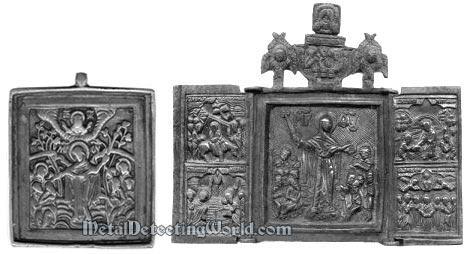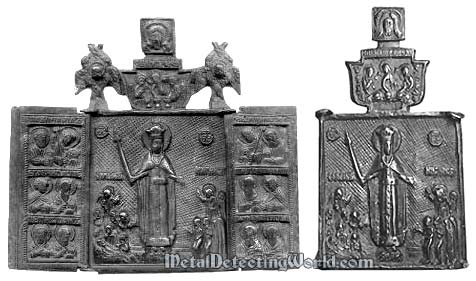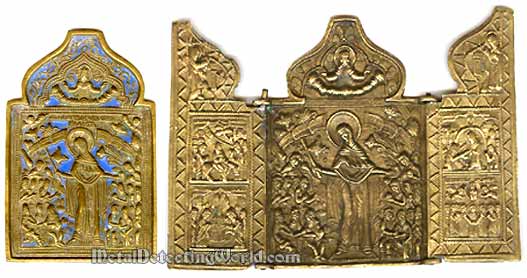Pectoral Travel Icons - Metal Detecting in Central Russia (Story 16)
Later in Russian history, the Old Believers favored this type of icon for their devotional practices and adopted it as a symbol of their unity partly because Tsar Peter the Great forbade the casting of icons. The "Mother of God - The Joy of All Mournful People" icon was one of the last miracle-working icons before the Raskol.
The Old Believers movement came into existence back in 1666-1667 when a small minority of believers resisted the reforms of some of the traditions and practices of the Orthodox Church introduced by Patriarch Nikon in 1652 under the order of Tsar Alexei.
As the Old Believers broke away from the mainstream Orthodox tradition, the Russian church and the state authorities often saw Old Believers as dangerous elements and as a threat to the Russian state. After 1685, a period of persecutions began, including both torture and executions. Many Old Believers fled Russia, however, Old Believers became the dominant denomination in many regions, including Arkhangelsk region, Kursk region, the Urals, Siberia etc.
Under Empress Catherine the Great (reigned 1762 - 1796) which introduced a new term "Old Ritualists" (staroobryadtsy), it became prohibited to refer to Old Believers as raskolniki (schismatics), a name they considered insulting. Only in 1905 Tsar Nicholas II signed an Act of religious freedom, which ended the persecution of all religious minorities in Russia. By the 1910s, about 25% of the population in Russia said that they belonged to one of the Old Believer branches.
The Joy of All Mournful People was the most popular cast icon of the Holy Virgin among Old Believers. Possibly, such extraordinary veneration is connected with the fact that this icon was one of the last miracle-working icons before the Schism (Raskol).

The most common type of the icon casting technique was so called "cast in lost wax." The artist created a model out of wax which could be mixed with oils, resin, tar or suet so it could be worked in an unheated state. The wax model, complete with each minute detail of the final icon, was then coated with moistened clay. After the clay had dried, the model was heated up to about 500 degrees Celsius.
The wax liquefied and drained through small drainage channels impressed in the clay while the clay was burnt to a hollow form. This form was then filled with liquid metal. After the metal had hardened, the form was broken and therefore lost for another casting - hence the term "cast in lost wax" was born.

In some cases, surface treatment was applied to beautify the icon. This could include adding either silver, gold, or enamel. Silver and gold fire gilding was done by mixing silver or gold with mercury to obtain a paste, which was applied thinly onto the icon. By heating the icon, the mercury would evaporate while the silver or gold would create a very resistant surface connection with the icon.
The intricate process of adding enamel to icons required glass to be melted onto the icons at high temperatures. In order to acquire the various colors, the colorless glass was mixed with metals or metal oxides: iron oxide for red, cobalt for blue, silver for yellow, copper for green, and pewter for white.
Bronze Travel Icons, circa 19th Century

Today, for a variety of reasons, brass-cast icons are especially important and valuable, mostly because they survived intact. The signs of wear to the soft brass of many are delightful metaphors of their cherished use.